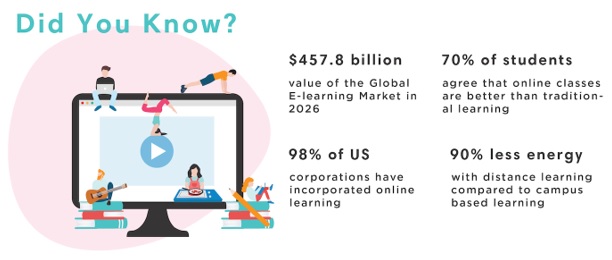Effectively Teach Today's Generation Students With 5 Key Principle Of Integrating Technology In The Classroom
25th July 2023
In this digital era, the way of consuming and delivering education is changing. The traditional method of teaching and learning is being replaced with E-learning and teaching. Online teaching classes for teachers mode is becoming the new normal nowadays because the E-learning market is becoming the biggest market in the education sector. According to upskillwise.com, it’s to be found out that the value of the Global E-learning market will touch $457.8 billion in 2026.

Source: https://upskillwise.com/online-learning-statistics/
There’s no doubt that if educators want to stay relevant in this digital era, they need to embrace this new way of teaching. However simply incorporating technology in the online classroom is not enough, educators need to understand that it needs to be strategic and with purpose and those educators who have pursued courses like Live Online International Teaching Diploma Course, knows it really well.
In this blog post, we will get to learn about 5 key principles which can guide educators on how they can integrate technology in the online classroom successfully.
Before moving to the topic, can we ask you a question? Do you follow us on Social Media? We regularly share upgraded educational content, tips, feedback and more. Check us out by clicking the profiles here - Facebook / Twitter / LinkedIn / Pinterest / Instagram / YouTube
So, without any further delay, let’s get started.
1. Inclusive and Accessible Learning Environment
One of the important principles of integrating technology into the online classroom is by ensuring accessibility and inclusivity for every student. With the help of technology, educators can fill the gap for every student who has a unique set of needs and abilities.
In this digital era, it’s every educator's responsibility to consider the diverse need of every student, and with the help of online teaching platforms and different technological tools, they can make education accessible to all. Integration of technology in online teaching classes for teachers can benefit especially those students who have special needs. For example, students with visual impairments can utilize screen-reading software, while students with hearing impairments can benefit from real-time transcription services.
By integrating technology tools and platforms in the online classroom, educators can create an inclusive environment for every student, which will help them to thrive academically.
2. Engaging and Interactive learning experiences
As the year progresses technology is changing and upgrading at a rapid fast pace. Nowadays, technology offers a wide range of resources and tools for education, which will help to increase the student's learning experience and engagement rate of their learning rate. Gone are the days of traditional passive learning, it got replaced with new and dynamic ways of learning which are virtual teaching and learning.
For instance, educators can utilize virtual reality simulations to take students on virtual field trips, allowing them to explore different cultures and environments without leaving their homes. Online discussion boards and collaborative platforms enable students to engage in meaningful discussions and collaborate with their peers, fostering a sense of community and active participation.
In addition, gamification can also be incorporated into online learning to make it more engaging and enjoyable for students. By incorporating game elements such as leader-boards, badges, and points, educators can motivate students to actively participate and strive for mastery. Through the integration of technology, educators can create a learning environment that is not only informative but also captivating and interactive, enhancing students' motivation and retention of knowledge.
3. Personalized and adaptive learning
One of the key principles of integrating technology in the online classroom is the ability to personalize and adapt learning experiences to meet the unique needs and preferences of individual students. Technology tools such as learning management systems, adaptive learning platforms, and intelligent tutoring systems can collect data on students' learning behaviours and preferences. This data can then be used to create the learning experience to each student's specific needs, providing personalized content, feedback, and support.
Adaptive learning platforms, for example, can dynamically adjust the difficulty level of content based on students' performance, ensuring that they are appropriately challenged and supported. This personalized approach to learning can greatly enhance student engagement, motivation, and ultimately, learning outcomes.
4. A Pedagogical Focus
While technology is a powerful tool, it is important for educators to remember that it should serve as a means to enhance pedagogy, rather than replace it. The integration of technology in the online classroom should always be guided by pedagogical principles and learning objectives. Educators must critically evaluate the effectiveness of technology tools and platforms in achieving desired learning outcomes.
For instance, if the goal is to develop critical thinking skills in online teaching classes for teachers, then they can leverage online discussion forums to facilitate thought-provoking conversations among students. If the objective is to enhance collaboration and teamwork, educators can utilize collaborative platforms that enable students to work together on projects and assignments.
5. Upgrade with Time
The integration of technology in the online classroom is not a one-time endeavor; it requires continuous learning and adaptation. Technology is constantly evolving, and educators must stay updated on the latest trends, tools, and best practices. Professional development opportunities, online courses, webinars, and conferences can provide educators with the knowledge and skills necessary to effectively integrate technology in the online classroom.
Moreover, educators must be open to feedback and continuously reflect on their own practice. By seeking input from students and colleagues, educators can identify areas for improvement and make necessary adjustments to their instructional strategies.
Integrate Technology into Online Classroom Successfully
In today’s digital era, every student likes to consume learning’s through online mediums. Educators need to keep in mind that if they want to stay relevant in this digital world then they need to adapt with time for online teaching classes for teachers method. However, those teachers who have pursued courses like Live Online International Teaching Diploma Course are ready to embrace this new way of teaching.
By learning all the above-mentioned principles, every educator will be able to integrate technology in a strategic manner, which will not just help them to achieve success in their career but it will also help those students who are consuming knowledge from online mediums and achieve success academically.
Find the right course for you and try out the course. WhatsApp us at: +66-81-262-8832. You can also mail us at act@asiancollegeofteachers.com.
Written By : Abhishek
Leave a Reply

